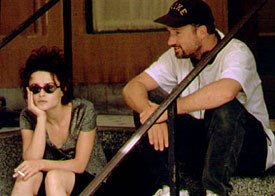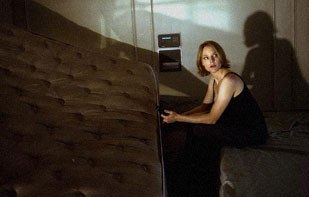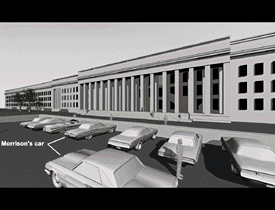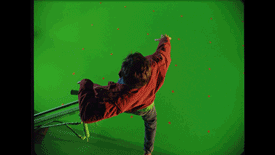Rick Baumgartner spoke with various effects artists about how previsualization is being used by directors as an important design and approval tool.

David Fincher on the set of Fight Club with Helena Bonham Carter. © 20th Century Fox.
During a pause in a recent motion capture session for a commercial, a director walks over to an artist sitting at a nearby desktop computer. On the monitor a flat-shaded 3D animatic of the spot plays in a loop. One can immediately see from the animation the touch of a master visual storyteller.
After reviewing the animatic on the monitor, the director speaks in his characteristic easygoing tone. "Trim three frames from the tail of the fourth shot," he says, "and add two frames to the head of the shot before it." The previs artist makes the changes and in less than a minute is ready for the director to take another look. He seems satisfied with the changes. Another shot in the animatic catches the director's eye. "Let's reframe the shot so that the character's head is more prominent on the left." The previs artist obliges, making the changes in the scene and re-rendering it. A few minutes later, the artist cuts the new render into the animatic and calls the director over for another looks. The process continues...
Previsualization has become an important tool for forward-thinking directors. For example, David Fincher's work with previsualization roughly parallels its rise from a visual effects planning tool to a key pre-production process linking the director, production designer and previsualization supervisor. In Fight Club, the director used previs to develop visual effects shots. Later, in Panic Room, he used previs to plan complex camera moves (as well as visual effects shots) on an intricate multi-level set. More and more directors are turning to previs specialists to capture their vision for the production and communicate it to the production team. Reliable 3D graphics software, increased graphics processing power and artist expertise have helped to encourage the growth of previsualization.
Would You Like Previs with That?
Lets be clear: previs is not the only solution available to directors for designing the production or communicating their evolving vision to key players on the production team. Previs supplements longstanding pre-production tools and methods used since the beginning of filmmaking (for example: thumbnail sketches, storyboards and concept art).
By definition, previs cannot show details of color, light, objects, tone, actors and props. Previs shines at showing moving spatial and temporal relationships between the camera and people, objects and environments. Previs allows directors to switch from a first person experiental cameras eye view to a third-person analytical Gods eye view of the digital or physical production environment.

Ron Frankel worked on Finchers Panic Room. © Columbia Pictures.
As Ron Frankel, previs supervisor (Panic Room and the upcoming Terminal) and founder of Proof Inc., explains: Previs is about planning, stage time is about execution. Previs is architecture for films. With previs, youre simultaneously designing and engineering. When you are working with a director, you are in camera POV. You are trying to convey a full range of emotions. Then you snap out to third person, [and] you are analyzing the experiences you just created.
So what determines whether or not a director previses a shot? The simple rule is that if its complex, a director should consider using previs. Complex shots include, but are not limited to, visual effects shots, shots involving multiple stunt players and vehicles, elaborate camera moves and large-scale battle sequences. Depending on the needs of the production, teams can previs everything from a single shot to the entire production, with most previs work falling somewhere in the middle.
Doing Previs
Previs teams typically consist of one to five people working in close proximity to the director. This team may consist of a previs supervisor plus one or more previs animators. In some cases, the previs supervisor serves as the previs animator and may perform other tasks such as visual effects supervision. Previs teams typically use off the shelf 3D graphics tools such as Maya, Lightwave, Houdini, Softimage XSI, 3ds max and Poser, plus editing tools such as Speed Razor and Premiere.
The previs team comes on board the project very soon after the director. A typical previs session is very much like a storyboard session: the director talks and the previs team draws. Depending on the complexity of the shot and the directors ability to convey direction to the previs team, previs update can take minutes or hours.
The previs supervisors first duty is educating the director about the benefits and limitations of previs. Top previs specialists try hard not to oversell previs. The previs teams next task is translating the directors internal vision of the story (or the complex parts of it) and storyboards into an external visual representation of the story.
Because directors can previs sequences in any order, the process allows them to revisit and tweak shots as more information becomes available. Fincher, for example, routinely works with his previs team during downtime in physical production, trimming a few of the previs frames here, adding frames there, recomposing a shot and so on. Commercial director Andrew Hardaway says: I make a creative decision and then I put a pin in it, and then I make another creative decision and put a pin it that and so on. I work across the canvas of the project and allow the project to grow with all of these decisions associated with one another.
In addition to providing a visual baseline for the crew, previs can also provide them with hard data (for example: camera setup information for the cinematographer, set dimensions for the production designer, motion control curves for the visual effects vendor). According to PLF previs veteran Colin Green, Our goal is to maximize the degree to which the previs unit can be an open resource and problem solving tool for the director and the crew, and minimize the possibility that the previs unit becomes isolated and creatively detached. To achieve this we try to ensure that all the members of the team are in contact with the different departments and interact with them frequently.


Hardaways step-by-step previs on a Volkswagen spec spot. Courtesy of Andrew Hardaway.
Why Does Previs Work?
And why is previs becoming such a powerful tool for directors? First, previs forces the director and his or her production team to depart the realm of the verbal and adventure into the realm of the visual. Since previs uses images instead of role-specific jargon to describe production issues there is a greater chance that crews will understand how the directors vision impacts their areas of responsibility. Everyone has the chance to contribute expertise regardless of departmental boundaries. Of course, previs also helps directors decide what not to include in the production. Second, previs allows directors to anticipate and prepare for financial, technical and creative challenges and risks inherent in transforming the directors vision into physical or digital characters, objects and events. This saves money by reducing on-set noodling while cast and crew sit paid but idle and the sun is sinking below the hills. Previs also allows directors to shoot with confidence on the day, by minimizing the noodling that can occur on sets.
For example, in a recent series of Honda spots, Hardaway worked out in previs complicated paths for multiple vehicles in a crane shot on location. At the shoot, the crew suggested alternate ways of getting the shot. But Hardaway was able to show the crew via previs exactly how and why the shot would work with the plan he developed. The shot went ahead as prevised and Hardaway (and the client) got the shot with minimal setup time.
Third, previs creates a living archive of the directors vision to which the team can refer throughout production. Previs allows directors to clearly communicate to the crew the approval state of a given shot or sequence. Says Zoic Studios Andrew Orloff, vfx supervisor for CSI: Miami, We know that once the animation has been signed off on, this is the direction of the shot. As an added bonus, previs enables new or replacement production team members get up to speed more quickly on your vision and the technical requirements of the shot.
Fourth, previs enables the director to predict and manipulate the visceral, emotional experience that the final images are likely to generate. Even more importantly, previs allows directors to communicate the emotional impact of a shot to people holding the purse strings for the show. According to Hardaway, Previs allows the whole body of work to take on a much more refined aspect it becomes the truest expression of what I want to convey.
Fifth, previs can boost crew morale by not wasting their efforts and budgets creating things the audience will not see. Says Hardaway, Production designers love to know where the camera is going to go so that they can put the money where it needs to be; they hate fabricating and dressing sets that are not used. Other key departments - stunts, props, grip, to name a few, can get similar benefits from previs.
Sixth, directors and production teams can use previs to help develop stunning new visual effects techniques. ESC Entertainment visual effects impresario John Gaeta (The Matrix trilogy) suggests: Previs is an evolutionary process. You start blocking shots that are so extreme, unlocking shots that no one could conceive of shooting these unless they were planned in a computer. Thats how we started with bullet time we made the leap by staying at conceptual creative stages, and then decided which shots we wanted to take to the extreme level of detail.
Finally, previs enables directors to optimize post-production time by creating an ongoing approved edit of the productions complex sequences well in advance of post-production. This means that directors can focus on nuances of performance, tone, pacing, color, sound and other important issues during post-production.
Previs With a Twist
Previs takes many different forms as it continues to evolve as problem-solving tool for directors. Some practitioners have used previs in a variety of unexpected ways.

Previs evolution on Path to War. Photo Courtesy of Andrew Hardaway © HBO.
Sometimes previs can help directors respond to challengers arising during physical production. Previs came to the rescue when world events impacted the shooting of a critical sequence in the late John Frankenheimers HBO film Path to War about the Johnson administration and the Vietnam War. The shot: a war protester lights himself on fire outside of Secretary of Defense Robert McNamaras Pentagon office.
The production had originally intended to shoot at the Pentagon but the September 11 attacks prevented the shoot from happening. Hardaway (who also supervised effects for Frankenheimer on the BMW film Ambush) worked with the director to previs the Pentagon scene. After designing the scene using previs, then filming the scene with stand-in portions of a practical set, they approached The Orphanage in San Francisco to execute a photo-real matte painting of the Pentagon for several shots in the final film. This preplanning allowed Frankenheimer to get exactly the shot he would have gotten had he been able to shoot at the Pentagon.

A lot of effects work had to come together in this Shania Twain video. Courtesy of Blur Studios.
Blur Studios creative head Tim Miller developed an innovative way to use previs for a recent Shania Twain music video. Miller conceived a story for the video based on a bare-bones concept document. He then created an animatic of the story, then shipped it off to the director. Says Miller: I forgot it was a music video and just tried to tell an exciting and cohesive story. I gave the animatic to the director and said take what you want. The result? Blur knew exactly what CG shots to create to blend with the live-action and the director shot the live action to coincide with the CG world prevised by Blur.
In television, the basics of previs still apply. According to Kyle J. Healey, vfx supervisor and previs supervisor for effects house Stargate Digital, In the context of episodic television, previs seems to lean more toward getting everyone on the same page as quickly as possible, rather than on the number of iterations afforded to a feature schedule and budget. Healey should know his credits include previs work on dozens of productions, including major feature projects such as Pearl Harbor, Shanghai Noon and Inspector Gadget.
But in short-turnaround world of episodic television effects, many times theres no time to previs live-action shoots, or things change during the actual shoot. Mat Beck, president of Entity FX in Santa Monica, has come up with a novel solution he jokingly calls midvis creating animatics immediately after the live-action shoot. Depending on the shot, Entitys midvis team for Smallville might consist of producer/supervisor Beck, 3D artists, vfx supervisor John Walsh as well as the shows writer, producers and creator.
Heres how Entitys midvis process works: Traditional hand-drawn storyboards communicate the basics of the shot to production framing, camera movement and angles and so on. For some complex shots (for example, Clark Kent on top of a CG building) the team takes the time to previs the entire camera movement. But often, the live-action sequence is shot from storyboards (i.e., without previs). And sometimes, responding to the unfolding events of production, shots have to be made up on the spot.
Close communication between Beck (who acts as supervisor and visual effects producer in Los Angeles) and on-set Canada-based visual effects supervisor Walsh results in live-action plates reflecting the storyboards and any on-set events. For sequence that will take a long time to assemble, Becks team creates rough composites of the live-action plates with added CG elements using low-count geometry and low-res or flat-shaded textures for objects, sets and environments. These composites are cut into the show, allowing for early feedback and giving Beck and the editorial team the opportunity to re-cut the sequence to match the rhythm of the anticipated CG shot. The method also helps Beck and Walsh flag any additional elements that need to be shot or created in CG to enhance the shots storytelling value. These new pieces can also act as placeholders and guides for the pickup shots.

Entity helps make a young Superman fly. Courtesy of EntityFX. © Warner Bros. Television.
Once the client has approved the midvis, Entity goes to work creating high-res elements and final composites. Using this methodology Entity allows Smallville to benefit from many of the advantages of previs most importantly extending the reach of the clients creative team without always having the traditional requirement that previs happen before shooting.
Prevising Previs
Any method or technology including previs can be over-used. As previs practitioners emphasize: Previs is not a silver bullet for all production ills. It cannot make a lousy script into a great show or an ill-conceived shot into a cinematic masterpiece. But for directors who know what previs can do and understand its limitations an entirely different level of control over and understanding of production becomes possible.
What does the future of previs hold? One possible future sees gaming combined with previs. Stargates Healey predicts: In the near future I expect to see more industry experimentation with realtime gaming engines to allow interactive previs with directors. Instead of the director coming into a previs session for comments, and coming back later after the scene renders, they can move a camera around together, in the middle of an animated scene.
The steady move to previs may have as revolutionary impact on production as the move to digital effects from optical effects. Why? Because previs takes 3D graphics technology into the entire film production process (production design, stunt coordination, production planning, special effects) while simultaneously taking visual effects out of its traditional post-production ghetto.


Watch as the city in the distance disappears. Courtesy of EntityFX. © Warner Bros. Television.
Perhaps the most important long-term impact of previs on the directors creative process is that it will break down barriers between production departments and roles inherited from a pre-digital age, thus allowing greater diversity of creative input by the team into the directors visual storytelling process.
For now, though, previs simply helps directors get the job done. As Hardaway says, One of the tasks I look forward to as a director is telling stories using challenging and interesting visual concepts, then using previs as a tool to help figure out how were going to shoot them.
Freelance visual effects producer/coordinator Rick Baumgartner was recently nominated for a 2003 Primetime Emmy Award for his work on the series finale of Buffy the Vampire Slayer. He can be reached at rick@vfxproducer.com or via his website: www.VFXProducer.com.








